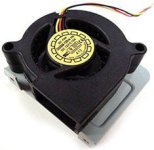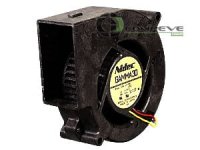You are using an out of date browser. It may not display this or other websites correctly.
You should upgrade or use an alternative browser.
You should upgrade or use an alternative browser.
Fan cooling controller
- Thread starter neptronix
- Start date
MrKang
100 W
deswong said:Hi All,
I've had no luck in fan cooling my controller because the fan itself doesn't take the roughs and bumps that I travel across. I have gone through two 40mm fans in the last few months and the blades on them keep breaking!
i wonder how you installed your controller on your bike..must be a very rough/hard ride to brake these little 40mm fans...
do you have a picture of yor setup?
Perhaps suspend the fan? then direct the air-flow to the controller through a flexible duct of some type?
gwhy!
100 kW
What sort of currents are you pulling, fets are you using and what the ambit temps, I have a 6 fet controller pulling 70A and it do not get warm let alone hot.
Jeremy Harris
100 MW
gwhy! said:What sort of currents are you pulling, fets are you using and what the ambit temps, I have a 6 fet controller pulling 70A and it do not get warm let alone hot.
My 6 FET controllers are similar, they barely get above ambient temperature, even after a fairly long hard climb at high current. Controllers usually only get hot because they are running too much current for the FETs. One of my controllers, that was fitted with the original P60NF06 FETs used to get hot at around 25A, now it's got IRFP3077 FETs it doesn't even get warm at double that current,
Jeremy
fans won't survive sand and muck...
Big aluminum heat sinks are better.
agreed on above comments, what motor and voltage/setup are you using this on ?
Big aluminum heat sinks are better.
agreed on above comments, what motor and voltage/setup are you using this on ?
lifepo4ever
10 kW
Ypedal said:fans won't survive sand and muck...
Big aluminum heat sinks are better.
agreed on above comments, what motor and voltage/setup are you using this on ?
next week i will increase the current of my 18 fets lyen and the first idea was to put fan put because the road is very rougth here the bearing of the fan won't survive even inside my plastic box but i came wtih another idea and use cpu heat sinks but again how can I hold them there because glue is not conductive so i want
to use termal paste ? maybe tie rap or rubber band
lifepo4ever
10 kW
like y pedal say because of the dirt of the road , also the bearing of the fan will die fast and i really thing if he put the controller face to the wind on is bike this will be enougth , i am lucky my 18 fets is waterproof so i can put everywhere i want on my ebike but i want add some heatsink but how to hold it there?
Ricky_nz
10 kW
You need something like this heat sink

Exposed so some in moving air, even if it is moving slowly will work very well.
Fans fail, heat sinks can't (they can become clogged so use wider fin spacing like this one.)
Also most after market PC fans are cheep rubbish.
There are better fans available if you are prepared to pay for them
Exposed so some in moving air, even if it is moving slowly will work very well.
Fans fail, heat sinks can't (they can become clogged so use wider fin spacing like this one.)
Also most after market PC fans are cheep rubbish.
There are better fans available if you are prepared to pay for them
The Kapton may well be better at conducting the heat than the adhesive heat transfer tape. You might want to check it's specifications beforehand, or at least do a before/after thermal test to see how much heat is really being moved from the FETs to the outside world.deswong said:proper heatsinking to the bar rather than how it currently is through the Kapton tape - I think this would result in some better heat transfer efficiency than how it currently is working. I have some Adhesive heat transfer tape (the stuff they use for CPU's) but insulated stuff, and will be putting that on.
The most effective simple way I've seen of improving heat transfer in these things is simply to remove most of the highly-overused thermal paste, and leave only enough to fill the scratches and tiny airgaps. If there are big airgaps, then either lap the heatsinks until they don't have them, and/or clamp them together more strongly by using a rigid steel bar on either side of it (not touching anything electrical) with strong bolts thru it, between the FETs, to clamp them very evenly and thoroughly.
Jeremy Harris
100 MW
deswong said:The Kapton may actually be better - although I have changed the FETS.
The Kapton tape, with a thin smear of heat sink compound, is about as good as you can get for transferring heat from the FET tab to the spreader bar. The FET is the weak point. No matter what you do outside the FET you can't overcome the rather poor thermal conductivity inside the FET, which is the primary cause of failure. Using low loss (i.e. low Rdson) FETs makes a very significant difference to FET internal heating.
deswong said:Usually I would use a very thin smear of thermal paste - but these FETS need to be insulated - they let out the smoke if you just clamp them to the bar. (experience has told me so...)
As you've discovered, it's a recipe for certain failure to fit FETs without some form of insulation between both the FET tab and the spreader bar and between the mounting screw and the FET tab. Heat sink compound is not an acceptable means of insulation. Either use Kapton or mica for FET tab to spreader bar insulation and always use the small 'top hat' plastic insulators under the FET screws.
deswong said:I have actually considered re-casing the controller and putting on a nice, proper finned heatsink - it's probably overkill for this controller though.
You'd be better off just using low loss FETs in a controller sized to do the job. If the heat isn't being generated you don't need to get rid of it, plus you don't waste so much power, either. Fans will only have a very modest effect and don't overcome the real problem, which is right inside the FET at the junction to case joint. No matter how much you cool the case you can't fix this fundamental restriction that TO220 package FETs have.
Jeremy
CamLight
10 kW
Very good advice! No insulation = very bad day for your controller.deswong said:Oh, again make sure you insulate the FETS - don't just thermal paste it!!! It will damage your controller. I ended up using silicone impregnated rubber, which has a similar thermal conductivity to the Fujik white thermal paste.
Which silicone insulators are you using? I've never seen one with a thermal resistance below about 0.6-degrees C/W (and typically around 1.0) whereas the typical silicone paste can easily achieve 0.03-degree C/W resistance...about 20 times less resistance. Which makes sense though because the compound is typically only a fraction of a mil thick once the FET is mounted where the rubber insulator is several mils thick and is a thermal insulator as well as a electrical one.
CamLight
10 kW
Most of the silicone insulators are only a few mils thick, which is quite thin.deswong said:These insulators were a bit expensive - $8 for 10 of them. Well, expensive compared to other methods anyway. They are quite thin.
What causes FETS to die? I went on a real-world test yesterday, and I swear one of the FETS have gone again - the controller was warm (not overly hot - you could hold the controller in your hand comfortably) and the wheel feels like it has some insane resistance against it. Also there is no 5v output anymore to the CycleAnalyst so I think this time something bad really happened.
But, their performance is miserable compared to just grease. Which you might be seeing if another FET blew.
The outside of the controller, or even the heat sink, can be much, MUCH lower in temperature than the FET junction temperature. It can easily be cooler by more than 100-degrees C.! Especially if using those silicone insulators. In fact, the worse the cooling system works (however simple or complex it is), the cooler the heat sink or controller will feel since the heat isn't being moved from the FETs to the heat sink or controller case.
There are others but typical failure mechanisms for controller FETs are over-temperature and over-voltage.
CamLight
10 kW
Agreed...but the silicone ones are awful.texaspyro said:There are thermal pads out there with very low thermal resistance.
Having said that though, there is a place for them and I have used them often. But, I run the numbers first to make sure it's not going to be a problem. If so, hard-anodizing the heat sink to insulate it is my next choice.
hydro-one
10 kW
one thing is to make sure the fets are not touching the heatsink. check with a multimeter. Its been said-- but it can be very tricky to get right when replacing multiple fets. use methods guide when repairing/modding controllers.
Similar threads
- Replies
- 4
- Views
- 233



